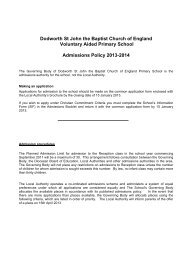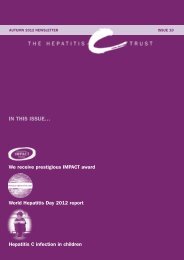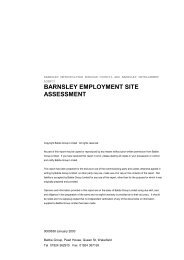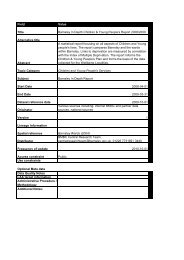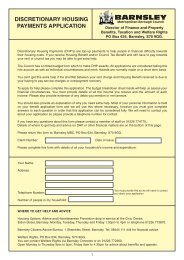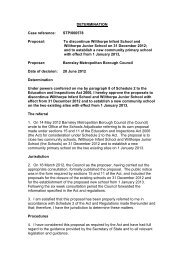Food and Nutrition Guidelines - Barnsley Council Online
Food and Nutrition Guidelines - Barnsley Council Online
Food and Nutrition Guidelines - Barnsley Council Online
You also want an ePaper? Increase the reach of your titles
YUMPU automatically turns print PDFs into web optimized ePapers that Google loves.
4. Babies 0-12 months<br />
Helpful tips<br />
There are a number of different br<strong>and</strong>s of infant<br />
formula milk available in the shops. All should<br />
meet the legal st<strong>and</strong>ards for formula milk <strong>and</strong><br />
it’s up to you to decide which one to use.<br />
In the past it was thought better to stick to one<br />
br<strong>and</strong>, but there is no evidence to suggest that<br />
changing br<strong>and</strong>s does any good or any harm.<br />
If you have any worries about the infant formula<br />
milk you are giving your baby, ask your midwife,<br />
health visitor or GP for information.<br />
Using formula milk safely<br />
Powdered infant formula milk must be<br />
prepared as carefully as possible. It is not a<br />
sterile product, <strong>and</strong> even though tins <strong>and</strong><br />
packets of milk powder are sealed, they can<br />
contain bacteria such as Cronobacter sakazakii<br />
(formerly known as Enterobacter sakazakii) <strong>and</strong>,<br />
more rarely, salmonella.<br />
If the feed is not prepared safely, these bacteria<br />
can cause infections.<br />
The risks of using infant formula milks are<br />
reduced if:<br />
• Fresh bottles are made up for each feed<br />
because it is impossible to destroy all the<br />
bacteria completely.<br />
• Feeds are made up using cooled boiled water<br />
that is still hotter than 70°C. In practice, this<br />
means using water that has been boiled <strong>and</strong><br />
left to cool for no more than half an hour.<br />
(See Appendix I for instructions for making<br />
up feeds).<br />
• Bacteria can multiply rapidly at room<br />
temperature <strong>and</strong> can even survive in the<br />
fridge, so storing made up formula milk for<br />
any length of time increases the chance of a<br />
baby becoming ill <strong>and</strong> should be avoided.<br />
• Any leftover milk should be thrown away<br />
after an hour.<br />
What types of infant<br />
formula are there?<br />
Milks that say they are suitable for<br />
newborns (sometimes known as “first<br />
milks”)<br />
These milks are based on the whey of<br />
cow’s milk <strong>and</strong> are more easily digested<br />
than the other milks. Unless your doctor<br />
or health visitor suggests otherwise, this<br />
is the best type of infant formula for your<br />
baby.<br />
If bottle-feeding, first milk is the only<br />
food your baby needs for the first six<br />
months.<br />
After six months continue to give first<br />
milk as you start to introduce solid food.<br />
When your baby is one year old, ordinary<br />
(full-fat) cow’s milk can be given.<br />
Milks that say they are “for hungrier<br />
babies”<br />
There is no evidence that babies settle<br />
better or sleep longer if given these<br />
milks. They are based on the curd of<br />
cow’s milk <strong>and</strong> take your baby longer<br />
to digest than first milks. They are not<br />
recommended for young babies.<br />
Milks that say they are for babies over<br />
six months (sometimes known as<br />
follow-on milks)<br />
Follow-on milks are described as suitable<br />
for babies from six months of age. It is<br />
not necessary to move your baby on to<br />
these milks. Follow-on milks should never<br />
be used for babies under six months old<br />
as they are not nutritionally suitable.<br />
However, the labels can look very similar<br />
to first milks so read them carefully.<br />
38



